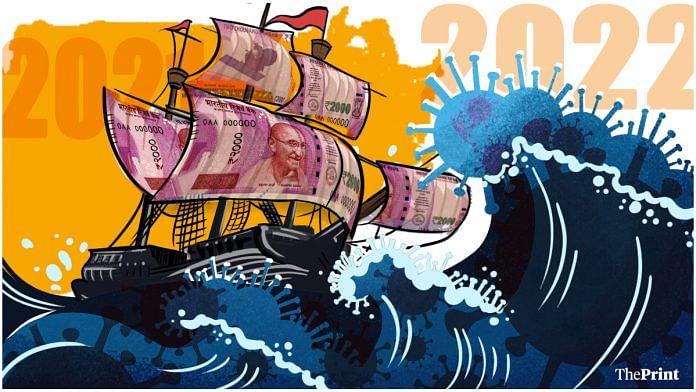Several big challenges lie ahead for the Narendra Modi government as India prepares to step into 2022: A new wave of Covid, maintaining macroeconomic stability and furthering the reform process to keep growth on a path to recovery.
Omicron
With another wave of Covid expected to hit India, the damage to life and livelihoods is expected to be lower this time due to vaccination, higher levels of immunity and our increased ability to cope.
Early this year, the Indian economy was gradually recovering until the severe second wave hit the brakes. But as the pace of vaccinations picked up and restrictions began to be lifted, economic recovery gained momentum.
The second wave was much more severe than the first, but its economic impact was primarily limited to the April-June quarter. While real GDP in the quarter was 9.2 per cent lower than its pre-Covid levels, it attained the pre-Covid levels in the September quarter.
Hopefully, even though Omicron spreads much faster, our ability to cope has increased and the economy will be less affected this time.
Also read: Omicron worries hit Indian economy just when it seemed poised to recover lost ground
Macroeconomic policies
There is limited space for either fiscal or monetary expansion now. If anything, monetary policy normalisation is on the cards. Moreover, policymakers will face a tight rope walk as they try to balance concerns about slow growth on the one hand, especially with another wave of Covid and restrictions, and high inflation on the other.
Advanced economies announced large fiscal packages to mitigate the distress caused by the pandemic.
In emerging economies where fiscal space was relatively limited, much of the policy support emerged from the central banks, which adopted a vast array of measures to enhance the flow of credit to restrict the economic damage. These included large-scale purchases of government bonds and lending to banks at eased rates to encourage them to lend to households and businesses.
As vaccination picked up and economies started to recover, the demand for goods and services bounced back. However, supply side constraints, shortage of raw materials, rise in commodity prices, clogged ports and shortage of shipping resulted in higher inflation. By October-November, it became clear that inflation is no longer transitory and has turned persistent and broad-based.
This led the central banks to indicate that they would taper the pace of bond-buying and would likely raise interest rates sooner than anticipated.
In the latest policy announcements, the US Federal Reserve announced a faster taper of bond purchases while Britain became the first G7 economy to hike interest rates. There is a risk that the Omicron variant could intensify supply side bottlenecks and further aggravate inflationary pressures.
As inflation becomes more entrenched, central banks do not have the space to pursue eased monetary policy.
Fiscal policy also seems to have exhausted its options as high deficits and elevated debt burdens have amplified vulnerabilities in the form of greater rollover risk. These vulnerabilities have constrained the ability of governments to follow expansionary fiscal policies.
One way to expand fiscally is to transfer payments as some advanced economies did. Another is through tax cuts. Now that the goods and services tax (GST) in India has stabilised, if the government wishes to undertake fiscal expansion, a cut in GST rates to 12 per cent should be among its top options to consider.
Avoid knee-jerk reactions
Mounting concerns about the new Omicron variant, hawkish commentary by central banks and diminished space to support economies could see markets remaining volatile.
However, as more clarity emerges about the effectiveness of vaccines, markets may stabilise after bouts of volatility. Exchange rates, interest rates and stock markets may witness some volatility.
Policymakers should keep calm, avoid knee-jerk policy responses and focus on macro fundamentals.
Improving productivity through reforms
A series of reforms were announced as part of the Aatmanirbhar package. States’ enhanced borrowing limit was raised from 3 per cent of 5 per cent of GDP, linked to the adoption of specific reforms. A new public enterprise policy was announced, looking to keep minimum public sector presence in the strategic sectors and privatise the rest.
Finance Minister Nirmala Sitharaman in her budget speech proposed to privatise two public sector banks (PSBs). This was a long overdue step to reform a financial system unable to supply credit for India’s growing needs. Three-fourths of the Indian banking sector is still owned by the government. Recapitalising banks year after year puts a serious fiscal strain especially at a time when macro stabilisation is a priority.
The Modi government needs to go ahead with legislative amendments to facilitate privatisation of two PSBs now.
Similarly, setting up of a resolution authority through the Financial Resolution and Deposit Insurance bill, a public debt management agency and bond market infrastructure reforms need to be expedited.
Ila Patnaik is an economist and a professor at National Institute of Public Finance and Policy.
Radhika Pandey is a consultant at NIPFP.
Views are personal.
Also read: Modi govt’s pandemic strategy focused on revival has worked. Economic indicators prove it






